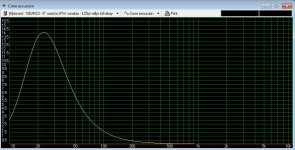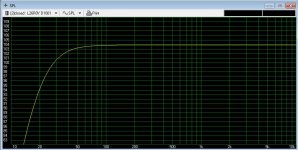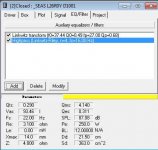When simulating cone excursion in WinISD pro/alpha, I have the graph set to show peak, i.e. the +/- (one-way) value. So its attempting to simulate the peak of driver deviation (not the RMS or total P-P movement).
But that seems to be based on a sinusoidal wave, and WinISD can't know what my music comprises in terms of sudden transients and other pointy bits. In practice, can I more or less trust WinISD's excursion simulations for designing within Xmax, and is it safe to assume that any unusual transients will still be within safe Xmech limits or should I leave a margin for error?
Cheers
kev
But that seems to be based on a sinusoidal wave, and WinISD can't know what my music comprises in terms of sudden transients and other pointy bits. In practice, can I more or less trust WinISD's excursion simulations for designing within Xmax, and is it safe to assume that any unusual transients will still be within safe Xmech limits or should I leave a margin for error?
Cheers
kev
Thanks for the help; very useful.
I'm really just starting out with it and wanted to get a feel for how real-world it is. It sounds like it'll be giving me at least a useful a ball-park though, so I'll continue to fiddle with it and then attach a file when I've got something worth looking at. (I'm trying to use a Linkwitz Transform and have a bit to learn first).
Cheers
kev
I'm really just starting out with it and wanted to get a feel for how real-world it is. It sounds like it'll be giving me at least a useful a ball-park though, so I'll continue to fiddle with it and then attach a file when I've got something worth looking at. (I'm trying to use a Linkwitz Transform and have a bit to learn first).
Cheers
kev
Hi, i've designed Many boxes over the years with WinISD, & they ALL turned out as expected. Plus i've never had any complaints about them, in fact just the opposite. And that's from lots of bars n clubs etc, some of them Major players 
Here's the latest version http://www.linearteam.org/download/winisd-07x.exe
Here's the latest version http://www.linearteam.org/download/winisd-07x.exe
Thanks! looks like I'm using an older version.
There are a few niggles with the version I've been using (not saving filters in projects, and having to run it in compatibility mode for win7, for example) BUT its free and I'm surprised how stable and usable it is for an alpha; it can do much more than the basic version I've used before so I'm pretty happy so far. If I'd tried to manually do even half of what I've done (in seconds) in winISD there would be mistakes all over the place
Cheers
kev
There are a few niggles with the version I've been using (not saving filters in projects, and having to run it in compatibility mode for win7, for example) BUT its free and I'm surprised how stable and usable it is for an alpha; it can do much more than the basic version I've used before so I'm pretty happy so far. If I'd tried to manually do even half of what I've done (in seconds) in winISD there would be mistakes all over the place
Cheers
kev
Okay I think I understand what I'm doing now. Attached are two pictures for cone excursion and SPL. These are for the SEAS L26ROY which has an Xmax of 14mm, a sensitivity of 87dB and its being fed with 50w system power. Then I've added a Linkwitz Transform with an fp=27hz and a Qp of 0,68.
I've managed to get down to around 30hz at -3db with an SPL of about 104dB@1m before I run beyond the 14mm Xmax. I did have to add a 4th order high pass filter at 16hz to contain the low frequency excursion, but maybe that'll help reduce room resonances.
I realise that this is very modest by subwoofer standards, but I'm thinking of using them as the bass driver in a 3-way rather than a stand-alone sub, so I'm only looking for SPLs that'll match a normal mid-bass range.
Does this seem reasonable?
Cheers
kev
I've managed to get down to around 30hz at -3db with an SPL of about 104dB@1m before I run beyond the 14mm Xmax. I did have to add a 4th order high pass filter at 16hz to contain the low frequency excursion, but maybe that'll help reduce room resonances.
I realise that this is very modest by subwoofer standards, but I'm thinking of using them as the bass driver in a 3-way rather than a stand-alone sub, so I'm only looking for SPLs that'll match a normal mid-bass range.
Does this seem reasonable?
Cheers
kev
Attachments
As long as you're realistic about the "50W system power", there's nothing wrong with that alignment IMO. Personally, I don't see needing 30Hz response if you plan to augment this system with a standalone subwoofer later on. You could probably get away with 35-40Hz F3 and get higher power handling. Just my take on it.
Seems most simulation programs show increased excursion linearly with increased power, while the reality is past Xmax there is progressively less motor force and generally more mechanical resistance of the spider and surround "putting the brakes on" excursion.Okay I think I understand what I'm doing now. Attached are two pictures for cone excursion and SPL. These are for the SEAS L26ROY which has an Xmax of 14mm, a sensitivity of 87dB and its being fed with 50w system power. Then I've added a Linkwitz Transform with an fp=27hz and a Qp of 0,68.
Does this seem reasonable?
Cheers
kev
Conversely, a very "loose" suspension won't have the electric motor braking when driven past Xmax, and given a powerful peak may hammer the voice coil on the top plate.
Much past Xmax, I would not trust excursion vs power predictions.
Last edited:
Seems most simulation programs show increased excursion linearly with increased power, while the reality is past Xmax there is progressively less motor force and generally more mechanical resistance of the spider and surround "putting the brakes on" excursion.
Conversely, a very "loose" suspension won't have the electric motor braking when driven past Xmax, and given a powerful peak may hammer the voice coil on the back plate.
Much past Xmax, I would not trust excursion vs power predictions.
Fixed it for ya.
Thanks both, looks like this is reasonable then. 
I'm thinking of using these modest subs in place of the standard bass driver in 3-way speakers (and crossing over quite low); I'll be using them mainly for music and only occasionally for film/movies, so I'm hoping that they will be enough to stand alone without a separate full-blown sub.
But its a good point on this being a waste of power if I had a separate sub; so with that in mind I'll probably design the enclosure to work well with or without the LT, then if I do go for a separate sub later on I could just remove the LTs for greater power handling and still get a good response curve.
Its also good to know that stuff about the reduced motor force & stiffening suspension vs lack of motor braking past Xmax - it makes sense but I'd not realised it until now. As there are these opposing effects its probably best for an amateur like me to assume they could work out against me and so I'll just aim to stay within Xmax, leaving the additional Xmech to cope only with unexpected peaks.
Thanks again
Kev
I'm thinking of using these modest subs in place of the standard bass driver in 3-way speakers (and crossing over quite low); I'll be using them mainly for music and only occasionally for film/movies, so I'm hoping that they will be enough to stand alone without a separate full-blown sub.
But its a good point on this being a waste of power if I had a separate sub; so with that in mind I'll probably design the enclosure to work well with or without the LT, then if I do go for a separate sub later on I could just remove the LTs for greater power handling and still get a good response curve.
Its also good to know that stuff about the reduced motor force & stiffening suspension vs lack of motor braking past Xmax - it makes sense but I'd not realised it until now. As there are these opposing effects its probably best for an amateur like me to assume they could work out against me and so I'll just aim to stay within Xmax, leaving the additional Xmech to cope only with unexpected peaks.
Thanks again
Kev
Superb, many thanks!
Yes, -3dB @ 30hz was what I was aiming for really; theres a fairly steep roll off afterwards, but I'm thinking that may avoid problems from the room - if I ultimately build these into 3-ways then I won't have such flexibility to position them like a separate sub.
Cheers
Kev
Yes, -3dB @ 30hz was what I was aiming for really; theres a fairly steep roll off afterwards, but I'm thinking that may avoid problems from the room - if I ultimately build these into 3-ways then I won't have such flexibility to position them like a separate sub.
Cheers
Kev
Check Amplifier Apparent Load (or something similar). You'll find you need much more than 50w. Maybe 500w or so.
Here's some reading.
ESP - The Linkwitz Transform Circuit
Chris
Here's some reading.
ESP - The Linkwitz Transform Circuit
Chris
Thanks Chris,
Yeah the simulations show more power needed for the frequencies at which the LT operates. I was quite concerned at first as it was truly enormous, but I seem to be able to reduce that drastically by using a bigger enclosure. I should have up to 150w continuous available from my amp; with the larger enclosure this seems like enough in the simulations, as I'm then running out of Xmax before apparent amp power.
My 50w is the normal system power that I seem to be able to reach, with the LT then adding to that as necessary. If I go above 50w as the normal system level, then the LT starts running out of head room for all the extra cone excursion it needs.
Cheers
kev
Yeah the simulations show more power needed for the frequencies at which the LT operates. I was quite concerned at first as it was truly enormous, but I seem to be able to reduce that drastically by using a bigger enclosure. I should have up to 150w continuous available from my amp; with the larger enclosure this seems like enough in the simulations, as I'm then running out of Xmax before apparent amp power.
My 50w is the normal system power that I seem to be able to reach, with the LT then adding to that as necessary. If I go above 50w as the normal system level, then the LT starts running out of head room for all the extra cone excursion it needs.
Cheers
kev
Yeah, the larger enclosure means the cone can move more freely (the air spring is more compliant), so less power is needed to move it around.
For not-much money, you can get rather a lot of rather clean power:
Samson Servo 550 Studio Monitor Power amp...275w per ch... | eBay
Alternatively, have a look at 2nd hand Behringer Europower amplifiers.
The amp on eBay will do a solid half-kilowatt and sounds good to me - I use one to power my 2x12" JBL sub.
You can, within reason, use a smaller enclosure and throw power at it. Just keep an eye on the subwoofer power ratings and I expect you'll be fine.
HTH
Chris
For not-much money, you can get rather a lot of rather clean power:
Samson Servo 550 Studio Monitor Power amp...275w per ch... | eBay
Alternatively, have a look at 2nd hand Behringer Europower amplifiers.
The amp on eBay will do a solid half-kilowatt and sounds good to me - I use one to power my 2x12" JBL sub.
You can, within reason, use a smaller enclosure and throw power at it. Just keep an eye on the subwoofer power ratings and I expect you'll be fine.
HTH
Chris
If you are using the same woofer for calculations (Seas L26ROY 10" Subwoofer - D1001-04) correct Le, Vas, Qes (Qts) from post #7.
If you are considering a 3 way, how are you managing the amp power, in passive crossover or like a 2-way active amp/crossover p/speaker?

If you are considering a 3 way, how are you managing the amp power, in passive crossover or like a 2-way active amp/crossover p/speaker?
They are more than enough, maybe better than a sub, @-10dB/20Hz at infrasonic territory for such a small 10" woofer and 90dB sensitivity, what gives 80dB at 20Hz for a standard speaker with no EQ/sub/amp and plus room gain.I'm thinking of using these modest subs in place of the standard bass driver in 3-way speakers (and crossing over quite low); I'll be using them mainly for music and only occasionally for film/movies, so I'm hoping that they will be enough to stand alone without a separate full-blown sub.
- Status
- This old topic is closed. If you want to reopen this topic, contact a moderator using the "Report Post" button.
- Home
- Loudspeakers
- Subwoofers
- Excursion in WinISD pro vs Xmax & Xmech


